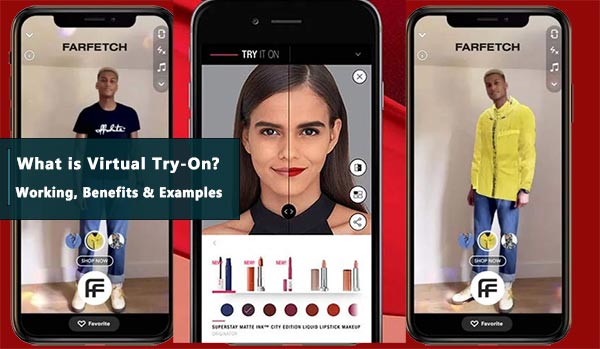This article will answer your quires like “What is virtual try on?”, How does a virtual try on work? and “benefits of Virtual Try-On”.
I want to buy a t-shirt online through an app. It is looking cool on model. Now the question is “Will it look good on me?”
To solve this problem of online shopping Virtual Try-On technology is being used through online shopping apps. Source: Zhang et al research paper
The pros and challenges of virtual garment try-ons are discussed, as well as which organizations use the technology in their supply chain. Continue reading to learn more! You may like to read another article on Augmented Reality vs Virtual Reality
What is Virtual Try-On?
Virtual try-on is a feature in shopping apps that helps customer to try on products, such as clothing, jewelry, and makeup virtually using their mobile phones or tablets. The technology is based on augmented reality which layers visuals over the real world via the device’s camera.
In other words, Virtual try-on technology lets customers see how clothes fit themselves or an avatar, allowing them to virtually “try on” clothing before purchasing them.
Trying on digitally produced garments or accessories in a virtual setting is known as virtual try-on. That means you can see how those goods look on you or an avatar, allowing you to determine whether or not they are a good fit without having to try them on. As a result, virtual try-on technology could allow you to try on items without having to wait for it to arrive or even leave your house.
Virtual try-on is available on online stores’ websites, applications, and social media pages. You can create your own virtual try-on solution or hire professionals to do it for you. Fittingbox, for example, is a plug-and-play solution.
The AR industry will reach $198 billion by 2025, up from $3.5 billion in 2017. When combined with 3D body scanning, AR technology will enable breakthroughs to revolutionize the fashion store experience. source: thetechfashionista.com
How Does Virtual Try-On Work?
Virtual garment try-ons come in many different forms. Virtual clothes can be tried at home as part of the e-commerce experience, or physical stores can be visited. Because they’re both virtual dressing approaches, they’re effectively the same thing. However, different solutions may suit different purposes.
Customers can try on products at home utilising 3D virtual fitting technology and a camera-equipped device via the internet. As the customer is captured by the camera-equipped gadget, the underlying AR technology overlays a realistic virtual rendition of the product over their real-world image to show how the object would appear on the customer’s body. If you’ve ever used Snapchat, you’re familiar with how it works.
The Benefits of Virtual Try-Ons
Virtual try-on benefits customers in making decisions. They can try out products at their own pace until they find the one that is suitable for them. For example, they can experiment with different coloured accessories to discover what looks best with the outfit they’re wearing.
Because customers may try before they buy, they are less likely to return things. They’re more likely to choose the correct product the first time around.
Virtually trying on clothes is also a pleasurable experience that customers want to share. Consider someone trying on your stuff on Snapchat and then posting their dazzling snap to all of their pals. That’s excellent brand promotion.
Read Also: Augmented Reality vs Virtual Reality | Top AR & VR Companies
Best Virtual Try-On Examples
1. e.l.f. Cosmetics
Unlike Snapchat, YouTube mostly uses paid commercials and influencer content to provide AR try-ons. To make this happen, Google has teamed with a variety of beauty tech companies, including Perfect Corp.
e.l.f Cosmetics’ AR advertisements on YouTube have been a huge success. Increased traffic, a lower bounce rate, and a 63 percent cheaper cost per unique user than past efforts were the end outcomes.
Below the e.l.f. Cosmetics in-stream advertising is a button that says “Try It On.”
When consumers press the button, their camera starts up and shows them the highlighted product. They can, for example, cycle through hue and shade selections, as you can see.
They can then select to buy the product by going to the e.l.f. Cosmetics website’s associated product page. Rather than looking at a photo of the lipstick, customers can connect with it on a deeper level this manner.
2. Farfetch
Farfetch has teamed with Snapchat to create virtual try-ons, as have other companies like Prada.
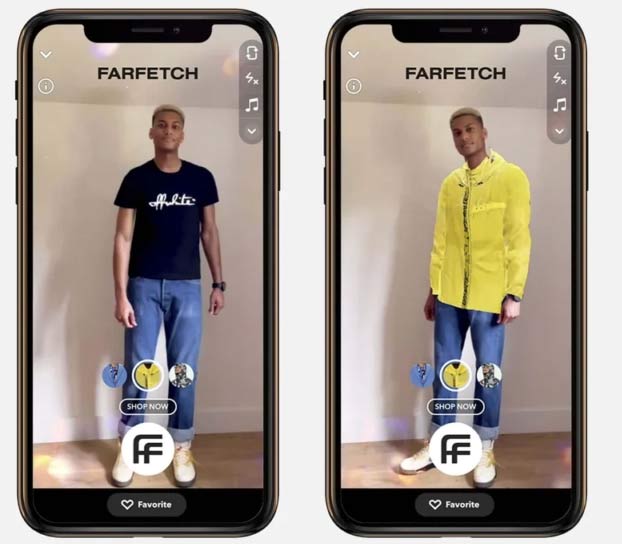
In the case of Farfetch, a user just stands in front of their camera and requests items such as “Show me a pattern windproof jacket.” The software selects a suitable product from the brand’s inventory and places it on their body.
It employs 3D Body Mesh technology to map the body and fabric simulations to make it appear as if the clothes are reacting to gravity in a realistic manner. Users can use voice commands to change attire, share their photos, and buy things directly from Snapchat.
3. L’Oreal
Instagram Shopping will now provide virtual try-ons for makeup brands thanks to a partnership with L’Oreal’s AR and AI subsidiary ModiFace.
Urban Decay, NYX, Maybelline New York, and Lancome are the first L’Oreal brands to use AR, with more to follow.
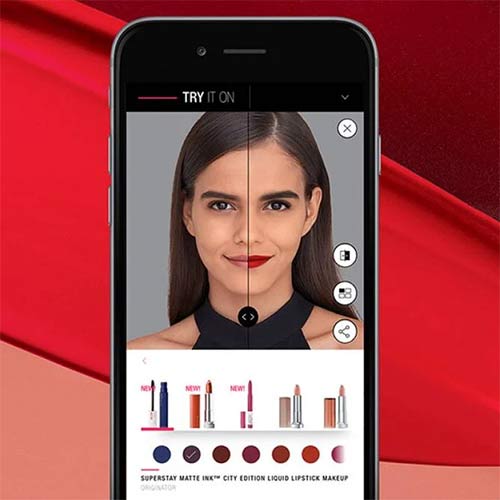
Customers use platforms like Instagram to seek beauty content and receive inspiration on what to buy, thus using AR capabilities on social media is a logical step for cosmetics and beauty brands. As a result, it’s simple to target customers through various channels.
Furthermore, social shopping is becoming more popular. Over 55% of social media users aged 18-24 and around 48% of users aged 25-34 in the United States had made a purchase using social media.
4. Baume & Mercier
It makes sense to offer a virtual try-on for high-end, expensive products because customers don’t make such purchases carelessly given the high price tag. So whatever you may do to assist them on their way will be useful.
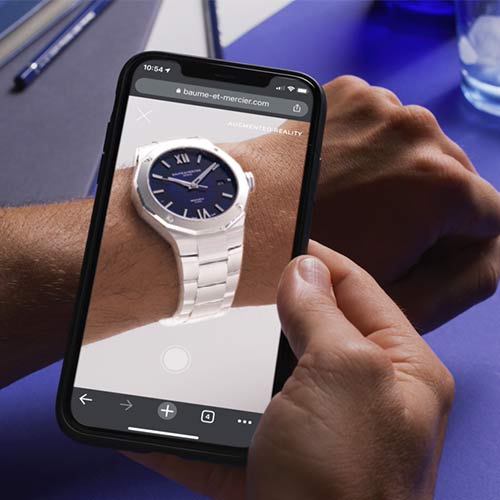
Baume & Mercier, a luxury watchmaker, collaborated with Haptic Media to develop an incredible virtual try-on experience on their website.
The timepieces were designed in numerous wrist sizes and variants to produce the virtual try-on, which adds to the realism of the experience. Lighting and shadow effects were also given significant consideration.
Haptic Media conducted user testing while developing the virtual try-on experience.
5. Wacoal
If you can leverage technology to alleviate a key consumer complaint, you’ve hit pay dirt. That’s exactly what Wacoal did when they collaborated with AI tech company Sizer to create the mybraFitTM bra sizing app.
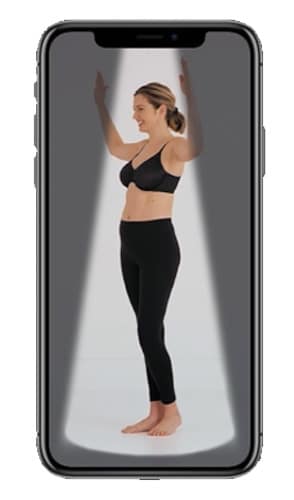
Shoppers are instructed to stand in front of their phone camera and perform various body poses. The program takes a few safe photographs and sizes the user digitally using a proprietary algorithm.
They must respond to a series of questions regarding their body size and shape. The customer then receives an email with their bra size and personalized recommendations from the Wacoal product catalog, and Wacoal saves the size in their profile.
Read Also: What is Immersive Technology? Applications & Future
Final Words
Virtual try-ons, as you can see, take e-commerce personalisation to the next level. It’s not just impressive but also persuading when someone can see what a watch or a clothing will look like in real life and in real time.
Customers can use virtual try-ons during the consideration stage of their journey. AR-assisted trial before you buy has been proved in case studies to enhance awareness and sales.
It’s definitely something worth considering for your company. The examples above indicate that as platforms and AR providers fight to offer the most realistic and user-friendly images, the technology is only getting better.
Article by
Dala
